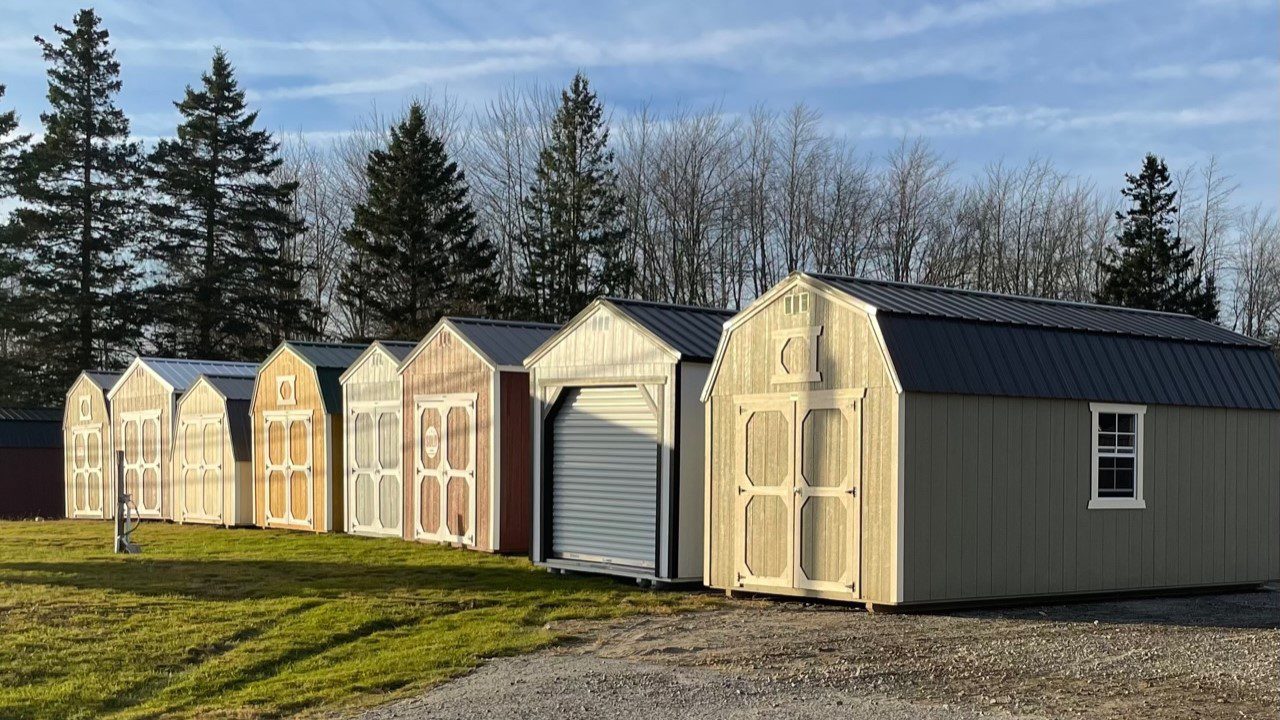Although the pandemic boosted the population of rural Down East Maine, the sudden rush of new residents sent Washington County’s already dire housing shortage spiraling, with much of the available housing stock scooped up.
Worse still, the scarcity of homes in Maine’s second-poorest county — where the poverty rate hovers around 20 percent and the median household income is less than $45,000 — puts the neediest residents at a huge disadvantage in the scramble to find homes.
Standing near an aging, unwinterized camper — their home, at least until spring — Arthur Worster and his partner Bryttani Ball said they never expected to find themselves without a place to live. Worster has lived in his grandparents’ East Machias home on and off for 20 years, the last few with Ball and her two teenage boys. After Worster’s grandfather died, the property, passed down for generations, transferred to another relative who decided to sell while the real estate market was hot. Although only assessed at $75,044, the home is surrounded by houses selling for as much as $430,000.

Worster and Ball had 45 days to find a new home.
“We’re losing everything,” Ball said while watching Worster and her sons gather salvaged wood from a demolished garage to begin building a house on Worster’s empty adjacent lot. “And it’s not just us. We found out there are like 20 other people right here in East Machias who are dealing with the same thing.”
Officials throughout the county report their housing inventory is almost nil. Properties at every price range were swept up in the buying frenzy, either by new, wealthier year-round residents escaping congested cities to enjoy the bucolic Down East landscape, or by locals eager to cash in while prices soared. According to realtors, affordable houses within reach of middle- and lower-income buyers are especially hard to find.
Debbie Holmes, a realtor based in Lubec, said her sale prices are “crazy high.” One home she sold in 2016 for $285,000 went back on the market this year and sold for $650,000.
The lack of affordable homes has stymied an innovative program to provide housing for migrants. Mano en Mano, based in Milbridge, is a not-for-profit agency providing services to seasonal migrants from as far as Haiti and Central and South America, who harvest wild blueberries in the summer and make wreaths in the winter. The program, called “Welcome Home Down East” would allow migrants who have been offered year-round work, a means of purchasing a home through a five-year, rent-to-own agreement underwritten by Mano en Mano. Launched as the pandemic struck, the plan to buy seven decent starter homes was crippled, according to the group’s housing director, Elan Gabel-Richards.
“Before, you could buy a reasonable home for under $120,000 that was, you know, not perfect, but something you could move into and fairly easily get a loan to purchase,” said Gabel-Richards. “Now, a $90,000 house that’s for sale is something that needs to be fully gutted and renovated.”
RELATED STORY: New faces showing up Down East
Compounding the problem for buyers and renters alike, many of the better homes that were bought during the pandemic — sometimes at double the assessed value — were converted into vacation and short-term rentals. A search on Apartments.com turned up only five rentals in the entire county; three of them were tiny efficiency or one-bedroom apartments, ranging from $800 to $1,600 per month, advertised as short-term rentals for traveling nurses and professionals. Machias Town Manager Bill Kitchen isn’t surprised.
“Across the board, there’s no low-cost housing, there’s no high-cost housing. There’s no middle-of-the-road housing right now,” Kitchen said. “We have doctors from the hospital who are looking, one commutes by airplane … The new dean of (the University of Maine at Machias) is desperately trying to find a house.”
After a fruitless search to purchase a house when he was hired last year, Machias’ new police chief, Keith Mercier, lived for two months in one of the UMM student dorm rooms. He’s since rented a house in Cutler, another temporary solution until he and his wife can find a house to buy closer to Machias. In the meantime, they’ve kept their home in Orrington and Mercier “bounces back and forth” on some weekends.
“Washington County as a whole really needs to take a hard look and put our heads together to find some sort of solution.” Mercier said. “It’s great if you can attract people here, but it’s not going to work out so well if they don’t have a place to live.”

Eastport City Manager Kate Devonshire, a Massachusetts native who moved Down East two years ago, wasn’t immune, either. With no rentals in the popular artist enclave and tourist destination, a temporary stay at her parents’ retirement home in downtown Eastport has lasted two years — and counting.
“I had no intention of staying with my parents,” Devonshire said. “It’s almost like a joke because I’m the city manager. I’m supposed to be out saving the city, you know?”
For those who are low-income, at risk or living on the margins, the housing crisis is no joke, and much more than an inconvenience. In many cases, living with relatives isn’t an option for a variety of reasons: no local family ties, not enough room or unhealthy home situations, to name a few. With few resources, many are forced to go it alone.
If they meet eligibility requirements, low-income residents can apply for a Maine Housing Authority Section 8 Housing Choice Voucher, which can pay as much as 70 percent of the monthly rent. If that sounds too good to be true, unfortunately, it is, in part due to the housing boom, but also because development of low-income housing in the county is stagnant.
According to the most recent Maine Housing Authority report, there are only 42 affordable housing complexes countywide with a total of 56 available units, but most units are only open to people who are disabled or over age 62. There were merely seven units open to the general population. So far, not much has been done to ease the shortage.
Over the last 16 years, although MaineHousing has backed 326 developments statewide, only four new developments were added in Washington County and are restricted. Three are supportive housing facilities earmarked for municipal, non-profit group, or tribal use; only one is a rental complex and it’s on the Passamaquoddy reservation, available exclusively to tribal citizens.
In addition to the Section 8 program’s long waiting list, houses must meet federal housing quality standards and rent limits — roughly $640 for a one-bedroom apartment. Since participation in the program is voluntary for landlords, and demand is so high, typical Washington County rents have ballooned far above the limits, according to Charley Martin-Berry, the executive director for the Community Caring Collaborative, a social services support network.
“It’s kind of like Willy Wonka’s golden ticket,” Martin-Berry said. “Even when you move up that list and you have a voucher in hand, it’s hard to find a place.”
Landlords are running businesses and making profitable choices, but the consequences for some of the most vulnerable populations can be catastrophic — homelessness or worse. Because Washington County doesn’t have tent cities or homeless shelters for general use, Martin-Berry said the country’s homeless are “invisible,” but they are out there couch surfing, or in the most dire circumstances, living in abandoned buildings and sheds.
“Those rent-to-own sheds are quickly becoming dwellings for people,” Martin-Berry said. “And it says right on them, this is not a house, these are not for habitation, but people are absolutely sheltering them.”

Washington County does have one shelter — for domestic violence victims. The agency provides victims with temporary shelter, historically, for three to four months, working with them to secure housing vouchers and find permanent housing. Marcie Dean, the housing director for Next Step Domestic Violence Project of Hancock and Washington counties, said victims are in the shelter much longer now, often twice as long, looking for permanent housing.
“Landlords just aren’t really open to the vouchers (from domestic violence victims) and they do have that monopoly right now where they can pick and choose kind of who they have as tenants,” Dean said.
For Washington County residents whose livelihoods can’t be relocated, like those making their living on the Down East waters, the struggle to find housing is compounded. Even before an estimated 80 new residents moved in, some fishermen in the small coastal town of Jonesport had struck out looking for housing in Washington County, forcing them to commute long distances to work every day.
That’s an extra hardship for lobstermen who begin their days long before sunrise. It’s also a hardship for the town, according to Jonesport Mayor William Milliken, because the fishermen take their families when they move away.
“It would be great to be able to house them here,” Milliken said. “We want their kids; we want them raising their families here.”
Faced with few if any viable housing alternatives, people throughout the county sometimes throw up their hands and relocate completely. Experts say the exodus of residents, coupled with the arrival of newcomers, is one of the best indicators of gentrification, a process that can strain resources and alter the character of communities. Tracking in- and out-migration since COVID has become a priority for county officials who worry about the Down East’s future.
The Sunrise Economic Council, based in Machias, works across many sectors to create jobs and promote economic growth throughout the county. Although it can be hard to quantify, according to its executive director, Charles Rudelitch, it does have some metrics to track out-migration. Rudelitch said that paying attention to those numbers along with other economic indicators will help community leaders fend off the potential pitfalls of gentrification.
“This is my hometown. I have a sense of just how much hardship the economic challenges in Washington County have created,” said Rudelitch. “More prosperity I think would be a wonderful thing for the region. But a gentrification that’s based entirely on investment income from away, that doesn’t create those same sorts of opportunities here. I think that could be highly problematic. It could raise the cost of living without providing the means to actually earn more money for the people who live here.”
Do you have important Washington County stories that we should cover? We want to hear your ideas by email: gro.r1755422846otino1755422846menia1755422846meht@1755422846tcatn1755422846oc1755422846.








